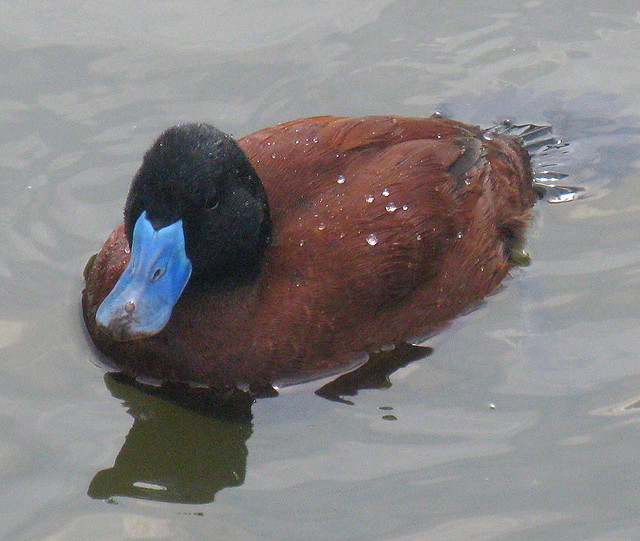
Maccoa duck(Oxyura maccoa)
Phylum —chordata
Class — aves
Order — anseriformes
Family — anatidae
Genus –oxyura
Appearance
As members of the stiff-tailed duck group, Maccoas are often found wading in the water with their tail feathers cocked upwards. As diving ducks, their bodies are specialized for being agile underwater swimmers and thus have sacrificed the characteristics that allow them to move well on land. As a result, their legs are set further back on their bodies which makes them awkward when walking out of water.
The breeding male Maccoa stands out with its cobalt blue bill extending from a completely black head and throat. The breast and back are chestnut colored while the underparts are often greyish-brown, the rump is dark brown, and the tail and feet are black. In flight, the male's off-white underwing feathers and white axillaries can be seen. Non-breeding males closely resemble the females, except for a few points: a darker crown and hints of chestnut color on the back.
The female Maccoa is less colorful. It boasts a greyish-black bill with a light tip, and a light brown face with a dark crown and cheek stripe, and an off-white throat. The female also has a light brown breast, darker brown back, off-white underparts, black feet and black tail feathers.
As with many birds, juvenile Maccoa ducks have similar plumage to adult females. However, their tail feathers are slimmer and notched, and their crowns are a darker brown.
Length – 48-51 cm, weight – 450-820 g.
Habitat
Maccoa duck is resident in Africa where there are two populations, one in eastern Africa and the other in South Africa. Movements take place over distances of less than 500 km.
Behavior
It is a diurnal species.
This duck is shy, less gregarious than other “oxyura”. It can be often found in pair or in family groups, and non–breeding birds gather in small flocks. Male is very territorial during breeding season. If an intruder or a rival enters its group, it chases it away from the territory.
Diet
The Maccoa duck is an omnivore whose diet consists primarily of aquatic invertebrates and plants.
Reproduction
This species mates and lays its eggs typically between January and May, and spends this time in small, defended freshwater habitats with emerging vegetation.
The male Maccoa ducks are polygynous - meaning a single male will mate with multiple females - and they aggressively defend their breeding territory. These males do not provide any help with nest building or parental care. After mating, females remain in the male's territory and either build a new nest out of sedges, reeds, and down, or sometimes occupy the pre-existing nests of coots and grebes.
Clutches are typically 5 or 6 eggs, but can reach up to 12 when females put their own eggs in another female's nest. In addition to this egg dumping, female Maccoas have also been observed abandoning their young both before and during incubation periods. The incubation period typically lasts from 25-27 days, but the fledging period is not well understood. Chicks are born with dark legs, feet, and bills, a white face, and are covered in grey-brown down.
In captivity
The lifespan is 6 years.
Keeping a Maccoa ducks in captivity is possible. To do this, it is necessary to provide a clean reservoir with running water, with above-water vegetation, as well as a dry and clean room in which birds can take shelter. This room should be heated during the winter season. Feeding birds in captivity is not difficult, they will get themselves most of the food in their pond.
In order for ducks to lay eggs at home, they need to be properly fed. Only then they will not have diseases associated with unusual feeds. The diet should include different greens from reservoirs: sea urchins, kelp and distichlis. Keeping wild birds in a pen can be simplified if you purchase special types of feed mixtures. It is better to give feed which isintended specifically for wild species.
 Russian
Russian
 English
English
























